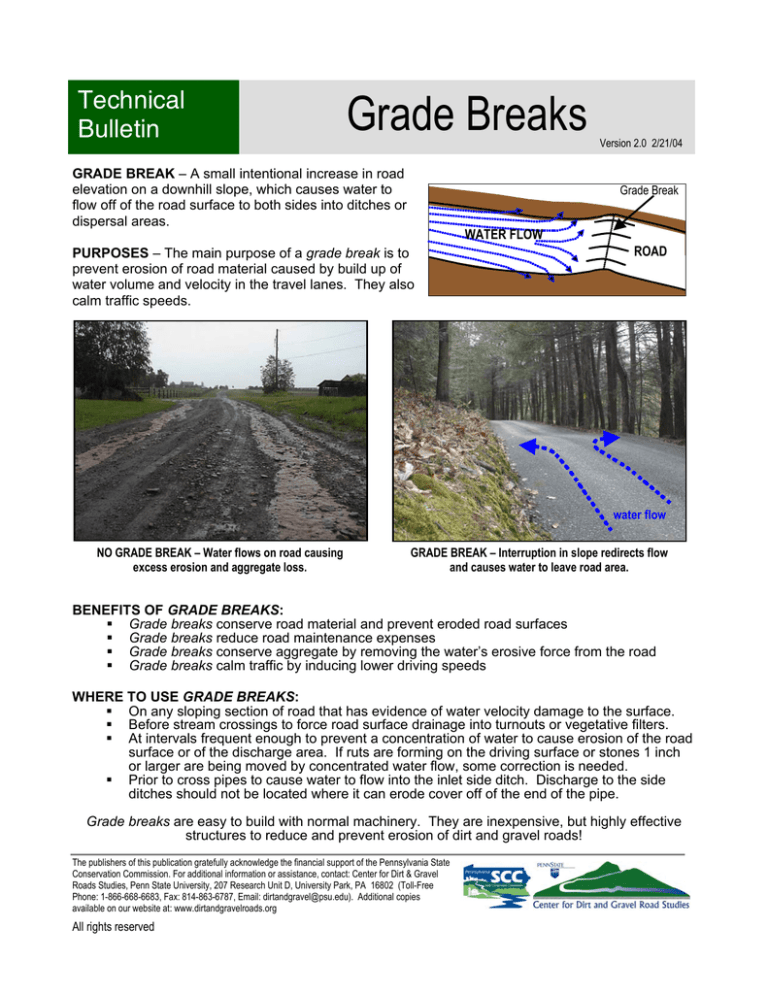
Technical
Bulletin
Grade Breaks
GRADE BREAK – A small intentional increase in road
elevation on a downhill slope, which causes water to
flow off of the road surface to both sides into ditches or
dispersal areas.
Version 2.0 2/21/04
Grade Break
WATER FLOW
PURPOSES – The main purpose of a grade break is to
prevent erosion of road material caused by build up of
water volume and velocity in the travel lanes. They also
calm traffic speeds.
ROAD
water flow
NO GRADE BREAK – Water flows on road causing
excess erosion and aggregate loss.
GRADE BREAK – Interruption in slope redirects flow
and causes water to leave road area.
BENEFITS OF GRADE BREAKS:
! Grade breaks conserve road material and prevent eroded road surfaces
! Grade breaks reduce road maintenance expenses
! Grade breaks conserve aggregate by removing the water’s erosive force from the road
! Grade breaks calm traffic by inducing lower driving speeds
WHERE TO USE GRADE BREAKS:
! On any sloping section of road that has evidence of water velocity damage to the surface.
! Before stream crossings to force road surface drainage into turnouts or vegetative filters.
! At intervals frequent enough to prevent a concentration of water to cause erosion of the road
surface or of the discharge area. If ruts are forming on the driving surface or stones 1 inch
or larger are being moved by concentrated water flow, some correction is needed.
! Prior to cross pipes to cause water to flow into the inlet side ditch. Discharge to the side
ditches should not be located where it can erode cover off of the end of the pipe.
Grade breaks are easy to build with normal machinery. They are inexpensive, but highly effective
structures to reduce and prevent erosion of dirt and gravel roads!
The publishers of this publication gratefully acknowledge the financial support of the Pennsylvania State
Conservation Commission. For additional information or assistance, contact: Center for Dirt & Gravel
Roads Studies, Penn State University, 207 Research Unit D, University Park, PA 16802 (Toll-Free
Phone: 1-866-668-6683, Fax: 814-863-6787, Email: dirtandgravel@psu.edu). Additional copies
available on our website at: www.dirtandgravelroads.org
All rights reserved
WATER FLOW
WATER FLOW
ROAD
ROAD
Height of grade breaks
exaggerated for illustrative purposes.
NO GRADE BREAKS – Water flows on road
causing excess erosion and aggregate loss.
GRADE BREAKS – Increase in slope disrupts
flow and causes water to leave road area.
IMPORTANT CONSIDERATIONS:
!
Spacing: On a long sloped road, multiple grade breaks may be used in succession to bleed
water from the road and prevent the buildup of erosive volume and velocity. The degree of
slope is the determining factor in grade break spacing. Steeper slopes require grade breaks
to be constructed closer together because water will build volume and velocity more rapidly.
!
Equipment: Most municipalities can make a grade break with their own equipment. A
bulldozer is preferred, but in most cases, a grader can be used.
!
Transitions: It is important to gradually taper the edges of a grade break back into the road
grade. Driving through the finished grade break in a car at a reasonable speed is one test of
this structure. If the ride is too rough or the car "bottoms-out", the structure needs to be
tapered more. The iron clad test of a grade break is the ability to plow snow. The plow
should ride into and out of the grade break without cutting the road surface. A good grade
break is very subtle.
!
Maintenance: Grader operators need to be instructed to maintain crown through a grade
break without eliminating it. Traditional grading operations strive to eliminate surface
deviations. Uninformed operators may see grade breaks as a source of road material for
use in other areas.
Grade Break
WATER FLOW
low
point
high
point
Top of
Grade
Break
water flow
ROAD
Height of grade break
exaggerated for illustrative purposes
Possible Culvert
Compressed illustration showing road surface water drainage
patterns at grade break.
GRADE BREAK- Notice the contour of ditch on the
left side of the road.
BROAD BASED DIPS:
A broad based dip is somewhat like a grade break except it conveys water from the uphill road ditch
and road surface across the road and to a discharge area. Broad based dips are also effective
structures in diverting water and will be the subject of a future technical bulletin.
This publication is available in alternative media upon request. The Pennsylvania State University is committed to the policy that all persons shall have equal access
to programs, facilities, admission, and employment without regard to personal characteristics not related to ability, performance, or qualification as determined by
University policy or by state or federal authorities. The Pennsylvania State University does not discriminate against any person because of age, ancestry, color,
disability or handicap, national origin, race, religious creed, sex, sexual orientation, or veteran status. Direct all affirmative action inquiries to the Affirmative Action
Office, The Pennsylvania State University, 201 Willard Building, University Park, PA 16802-2801; tel. (814) 863-0471; TDD (814) 865-3175. U.Ed #RES-01-50.
All rights reserved



